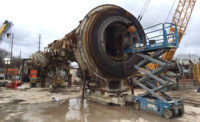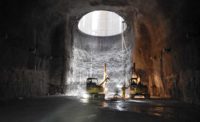Best Civil/Infrastructure


The $212-million Croton Tunnel project in New York was extensive. It entailed construction of a raw water tunnel from the New Croton Aqueduct to the Croton Water Treatment Plant, which is currently under construction, and two treated water tunnels between the plant and existing distribution lines adjacent to the Jerome Park Reservoir in the Bronx.
“It was a good design, and the contractor came up with good proposals,” says Syed Haq, resident engineer with URS, which is the construction manager along with joint venture partner Malcolm Pirnie. Both have offices in New York.
The general contractor, a joint venture between Schiavone of Secaucus, N.J., and John P. Picone of Lawrence, N.Y., used drill and blast to create a 14.5-ft by 14.5-ft horseshoe-shaped excavation for the 825-ft-long, 12-ft-diameter cast-in-place raw water tunnel.
The raw water tunnel crosses 70 ft above a major city water tunnel that was constructed in 1917. The team protected the tunnel from damage caused by blasting vibration. As a result of the test-blast program, rounds were limited as the excavation passed above the water tunnel.
“That was a critical issue, so we had a blasting program and monitored with piezometers and vibration meters,” Haq says. “It slowed us down a little because of all the extra precautions we took.”
Crews blasted into the aqueduct, built in 1892, to connect the new tunnel and found picks and shovels from the original job.
“One of the most interesting aspects was the connection to the aqueduct,” says Jim Morris, deputy resident engineer for URS/Malcolm Pirnie and a Malcom Pirnie employee. “Seeing how well they have stood up over the years, it seemed the brick and mortar was as solid as the day it was put it.”
The initial plan called for the entire tunneling as a drill-and-blast project; however, the contractor suggested using a tunnel-boring machine (TBM) for the treated water tunnels to save time and improve safety.
The TBM created a 13.5-ft diameter excavation for the two tunnels carrying treated water. The machine bored through a 100-ft-long fault zone, an area of decomposed rock. To avoid difficulties, crews drilled from the surface and grouted that region.
“We had good teamwork and were able to finish a good product ahead of schedule, under budget and safely, without anybody getting hurt,” Haq says.
The project began in August 2006 and finished in February 2011.
Water Tunnels and Associated Works: Croton Water Treatment Plant
New York
Key Players
Developer/Owner: New York City Department of Environmental Protection, New York
Construction Manager: URS/Malcolm Pirnie, a joint venture, New York
General Contractor: Schiavone-Picone, a joint venture, Secaucus, N.J.
Lead Designer: AECOM/Hazen and Sawyer, a joint venture, New York
Civil Engineer: Parsons Brinckerhoff, New York
Submitted by: URS/Malcolm Pirnie


